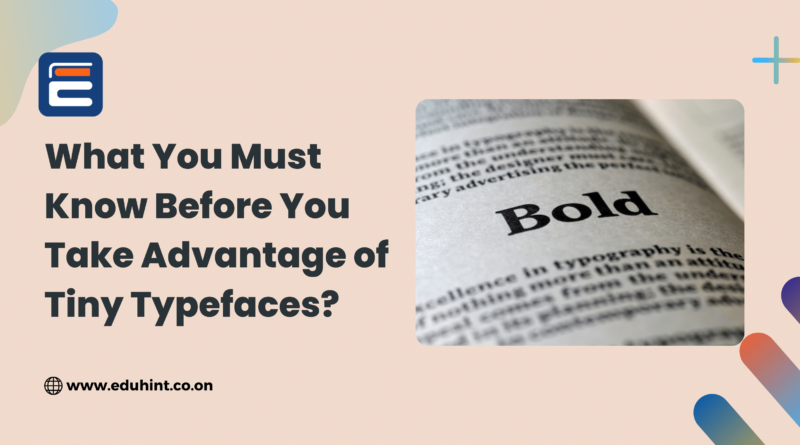4 min readWhat You Must Know Before You Take Advantage of Tiny Typefaces?
In today’s visual-centric world, design choices matter more than anything in shaping user experiences. From websites to social media graphics, the fonts you choose can impact how information is perceived and understood. Amidst tons of typefaces, tiny texts, also known as small texts, have become increasingly popular in recent design trends. They offer a sleek, modern aesthetic and can be an effective way to draw attention to important messages quickly.
So, are you a design enthusiast or digital content creator? Thinking about using tiny typefaces in your designs? Hold your horses! Before you begin, there are certain considerations to keep in mind. In this article, you will learn the essential aspects of tiny typeface and harness its benefits to the fullest. Let’s dive in!
Advantages of Tiny Typefaces
Tiny typefaces are still in use as they are excellent elements for crafting stunning designs. More than you think, there are plenty of advantages to using it, and a few of them are mentioned below.
- Tiny fonts or small typefaces are ideal to meet a clean and minimal aesthetic which is correlated with contemporary design.
- Tiny typefaces allow designers to include more information in even small spaces. It is particularly beneficial for mobile interfaces or data-heavy layouts.
- Well-designed tiny texts are capable of emphasizing specific elements within the design and attracting viewers.
- If you’re really impressed with it, make use of a small text generator to ease your typography selection and enrich your design effortlessly.
The Challenges in Small Text Designs
Tiny fonts can be challenging for individuals with visual impairments or older viewers who may have difficulty reading small text.
- When shrunk too much, fonts lose their definition and make it difficult to decode the text. This can lead to frustration and confusion for uses at times.
- Tiny fonts rarely translate well across different screen sizes and devices. They might appear blurry or unreadable on smaller screens, which may hinder the user experience.
- But these challenges aren’t the final fate. There are a plethora of ways to overcome these challenges and reap the special benefits it offers to designers.
Tips to Make the Most Out of Your Tiny Typefaces
- Consider Context and Content
Not one size fits all! Similarly, tiny typefaces may not be suitable for all types of content that you create. Therefore, consider the context and content of your design when deciding whether to use tiny typefaces. With expert guidance or your knowledge, decide whether tiny typefaces communicate your message effectively and enhance the overall user experience.
2. Stick to Brand Consistency
It is true that tiny typefaces can add visual appeal to your designs. However, it is crucial to maintain brand consistency across all of your marketing materials. So, pick a typeface using a tiny text generator that align with your brand’s tone, personality and visual identity. The consistency of your design helps you to enhance brand recognition and build trust among your audience. So, don’t miss it out!
- Ensure Legibility and Readability
The most important factor to consider when using tiny typefaces is legibility and readability. So, before using any typefaces, make sure to test them at various sizes to confirm that they look legible across different devices and screen sizes.
- Check for Accessibility of Texts
When designing with tiny typefaces, accessibility should be your top priority. Whatever you do, double-check that your content remains accessible to all users. It is advisable to use sufficient color contrast between the text and background. Also, avoid using tiny typefaces only to convey important information.
- Optimize for Mobile
Tiny typefaces may look crisp and clean on a desktop monitor, but they can become invisible when viewed on a smartphone or tablet. So confirm its visual appearance, test them on various devices and make the text readable and interactive for the viewers. It is good to neglect fonts that require users to pinch or zoom in to read as this can distract users easily.
- Test and Tweak Changes
Once your small text is ready to print or publish, you must gather feedback from your friends or colleagues and conduct thorough testing. The input you gather from individuals with varying levels of visual and device preferences will be beneficial for you to make your design more accessible for users. You can do A/B testing to compare different opinions and determine which option performs better.
Wrapping Up
To wrap up, tiny fonts are a smart choice, but they require careful consideration and responsible implementation. With the tips discussed here, you can rectify the challenges that may arise on your way and reap the rewards without fail. Though you are confused, simply think from a reader’s perspective and optimize your designs accordingly. This way, you can meet viewers’ expectations, convey your intended message, and achieve the goal behind it.
Happy Designing 🎉




